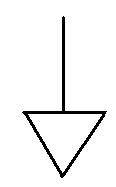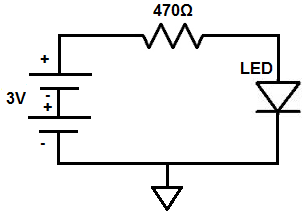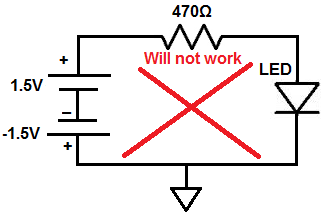Why does a Circuit Always Have to Have Ground?

Does a circuit always have to have a ground in order to work?
The answer is, ground is really a relative term.
There are many types of grounds to be considered, but the 2 main types that exist are earth ground and floating ground.
A circuit must either have an earth ground or a floating ground in order to work.
An earth ground and a floating ground are very different. And some consider an earth ground a true ground while not considering a floating ground a true ground.
Regardless of consideration, we will now go into depth, explaining the difference between an earth and floating ground
which you must encounter in a circuit for it to operate.
Earth Ground
An earth ground is what most engineers would consider a true ground.
An earth ground is when a circuit has a physical connection to the earth, in order to sink electrons through to a ground connected to the earth.
This ground is normally present on an electronic device that is powered by an AC plugged connected to an AC wall outlet. This type of ground is one in which the plug has 3 wires. With a 3-prong plug, one wire is positive, one is negative, and the other is the earth ground prong. This type of prong provides extra electrical protection. Because it has a direct connection with earth ground, it is only to sink electricity to the earth, giving less risk of a fire. Ground serves as a safety measure in circuits that are hooked up to earth ground. When a circuit is grounded directly to the earth, it is a safe line, because the earth is a huge reservoir that acts as a major sink for electrons. If a technician were to touch an earth ground, instead of the electrons sinking into the person, they would sink into the earth. When you make sure at least one side of your circuit is common to earth ground, it presents no shock hazard for a person touching ground. Ground is a neutral 0-volt line. The other type of ground is floating, or virtual, ground. This ground is not directly connected to the earth, and, thus, floating. Many battery circuits contain floating grounds and do not have to contain earth grounds because they carry a small amount of voltage. Thus, there's no real possibility of shock. However, for high-voltage applications, earth ground is essential, since the high voltage can be lethal to a person. This is why the circuit should be designed to sink directly into the earth.
Normally, again, only devices connected to AC mains has an earth ground, and this is only some of them. AC devices that have plugs with only 2 prongs do not have an earth ground wiring. Therefore, they do not provide extra electrical protection.
Only circuits do not have to have an earth ground connection in order to work. It simply, though, is a great extra safety enhancement.
So this leads us to the other ground, which is floating ground.
Floating Ground
So now we will discuss floating ground.
Floating ground, again, is considered by many to not be a true ground, as it doesn't have a physical connection to the earth ground.
However, it is still considered as a ground.
Floating ground is a type of ground in which the ground doesn't have a physical connection to the earth; it simply serves as a type of 0V reference line that serves as a return path for current back to the negative side of the power supply.
Circuits that aren't connected to earth ground must have a floating ground.
Floating ground really means a 0V reference line.
As an example, let's take the circuit shown below.

This is a circuit powered by a 2 AA batteries, giving a total voltage of 3V in order to light up the LED.
Circuits powered by batteries do not have an earth ground. Batteries do not have have a connection to the physical earth. So most DC-powered circuits, especially by batteries, have a floating ground, not an earth.
So the above battery-powered circuit has a floating ground.
So what is meant by a floating ground is that it does not have a connection to the physical earth, so it's simply floating (not connected) relative to the earth.
However, the floating ground serves as a 0V reference line. Ground also serves as a reference point in a circuit. It is a 0-volt line of reference. So if you have a 5-volt voltage source, from ground (0 volts), it is 5 volts. Voltage in a circuit is always measured with respect to ground. A great analogy to think of is when you are measuring your height. Where do you measure yourself from? From the ground, 0 inches off the floor. With respect to the floor, you're X feet X inches tall. Ground is that line of reference for measuring in a circuit so you can keep track of voltage.
Another term that is used to describe voltage is an electric potential. Voltage, or electric potential, is always referenced from a point, and this point is usually a 0V reference line. So relative to the floating ground of this circuit, which is 0V, the positive terminal of the battery gives out +3V of power. Without this 0V line, the voltage, or electric potential, wouldn't be 3V.
As an example, let's take another circuit that lacks a 0V refererence line as the ground point.

So this circuit has no 0V reference line serving as the ground. Therefore, it will not work. The reference line in this circuit is -1.5V. The positive power supply, which is +1.5V, referenced to the -1.5V nets a voltage output of 0V. Therefore, this circuit has no positive net voltage, so it's as if there's no power. So there's no 0V reference line. The positive voltage is cancelled out. And there's no floating ground.
Another purpose of floating ground, besides serving as a 0V reference line is to serve as a return path for current in the circuit. A circuit loops over and over and over with a floating ground. A power supply supplies the current, that goes through the load, turning it on, and then returns back to the negative terminal of the power supply, over and over and over again. A floating ground allows this to occur infinitely in a loop.
So, in conclusion, does a circuit have to have an earth ground in order to work? Absolutely not. Many circuits don't have a physical and direct connection to the earth. Electronic devices that pose a safety hazard normally do have one for extra protection, but it isn't an a requirement for a circuit to work.
If a circuit lacks an earth ground, though, it must have a floating ground. A floating ground serves as a 0V reference for the positive voltage supply so that it outputs a net positive voltage great enough to power the circuit. It also serves as a return path for the current back to the negative terminal of the positive supply. It isn't an absolute requirement for the reference voltage line to be 0V but it normally is designed this way the majority of the time, because it's the way that makes sense. If the reference voltage isn't 0V, the positive voltage supply must be greater than the negative voltage supply. But this normally doesn't have to be taken into account because normally the line is designed to be 0V.
So, in conclusion, a circuit must always have an earth ground or a floating ground in order to operate.
Related Resources
Source Transformation of Circuits
How to Read a Digital Voltage in Circuitry
What is the Admittance of a Circuit?
What is Impedance?
When a Circuit Needs Buffering
